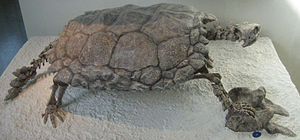Proganochelys
| Proganochelys | ||||||||||||
|---|---|---|---|---|---|---|---|---|---|---|---|---|

Proganochelys quenstedti in the American Museum of Natural History |
||||||||||||
| Temporal occurrence | ||||||||||||
| Upper Triassic ( Norium ) | ||||||||||||
| 228 to 208.5 million years | ||||||||||||
| Locations | ||||||||||||
| Systematics | ||||||||||||
|
||||||||||||
| Scientific name of the subordination | ||||||||||||
| Proganochelydia | ||||||||||||
| Romer , 1966 | ||||||||||||
| Scientific name of the family | ||||||||||||
| Proganochelyidae | ||||||||||||
| Baur , 1888 | ||||||||||||
| Scientific name of the genus | ||||||||||||
| Proganochelys | ||||||||||||
| Baur, 1887 | ||||||||||||
| species | ||||||||||||
|
||||||||||||

Proganochelys ( Greek for “before-turtle” from Progano “before” and chelys “turtle”) is one of the oldest extinct turtles. It comes from the Upper Triassic ( Norium ) of Germany , Greenland and Thailand . The armor length could reach 70 cm.
features
The skull shows some primitive features. The skull type is apparently anapsid (without a temproal window), very massive and not kinetic. However, the latest findings show that turtles were diapside reptiles. It is wide and not very elongated. The nasal cavities are completely separated from each other. The eye sockets are very wide. The jaw was toothless and probably had a horned beak. The square was deeply indented to support the large eardrum . The palate still shows primitive features. The pterygoid and vomer still have teeth. Furthermore, the roof of the mouth is only loosely attached to the skull. The carapace is only slightly arched and the rear part of the carapace is strongly jagged and has prickly appendages. The cervical section is clearly pronounced. The bridge is wide and strong, the plastron is cross-shaped.
Paleobiology
Proganochelys probably lived in a terrestrial or at least semi-terrestrial habitat.
Paleoecology
Proganochelys was found in Trossingen in a debris flow on the edge of a fossil lake. Together with this genus, plateosaurs and hybodonte sharks were found in Halberstadt .
Systematics and taxonomy
Since the discovery of Odontochelys and Pappochelys , Proganochelys is no longer considered the oldest representative of the turtles . The following cladogram shows the closest family relationships.
|
|
|
||||||||||||||||||||||||
|
|
Geographical distribution
Proganochelys was found mainly in Germany. Other finds come from Thailand and Greenland .
Stratigraphy and time horizon
All specimens found so far come from the Upper Triassic ( Norium ). In Trossingen was Proganochelys in Lowenstein lineup found.
Selection of museums with copies
Germany
- Museum of Natural History , Berlin
- Museum at the Löwentor in Stuttgart (State Museum for Natural History Stuttgart)
- Paleontological collection of the University of Tübingen
United States
Sources and References
literature
- Marian Mlynarski: Testudines. Handbook of Paleoherpetology, Part 7, Verlag Dr. Friedrich Pfeil, 1976.
Web links
- http://www.palaeocritti.com/proganochelys
- https://paleobiodb.org/cgi-bin/bridge.pl?a=basicTaxonInfo&taxon_no=37585
Individual evidence
- ↑ G. Baur: About the origin of the extremities of Ichthyopterygia. In: Annual reports and communications of the Upper Rhine Geological Association 20 , 1887, pp. 17-20
- ^ A b c d e E. S. Gaffney: The Comparative Osteology of the Triassic Turtle Proganochelys. In Bulletin of the AMNH 194 , 1990, pp. 1-263
- ↑ a b c F. A. Jr. Jenkins, NH Shubin, WW Amarel, SM Gatesy, CR Schaff, LB Clemmensen, WR Downs, AR Davidson, NC Bonde & F. Osbæck: Late Triassic continental vertebrates and depositional environments of the Fleming Fjord Formation, Jameson Land, East Greenland. In Meddelelser om Grønland, Geoscience 32 , 1994, pp. 1-25
- ^ A b c E. Buffetaut & V. Suteethom: The geographical significance of the mesozoic vertebrates from Thailand. In Biogeography and Geological Evolution of SE Asia , Backbuys Publishers, Leiden 1998, pp. 83-90.
- ↑ a b c M. Mlynarski: Testudines. Handbuch der Paläoherpetologie, Part 7. Verlag Dr. Friedrich Pfeil, 1976, pp. 1–129.
- ↑ a b M. J. Benton: Paleontology of the vertebrates. Publishing house Dr. Friedrich Pfeil, 2007, pp. 1-472.
- ↑ a b R. R. Schoch, HD Sues: A Middle Triassic stem-turtle and the evolution of the turtle body plan. In: Nature . 2015. DOI: 10.1038 / nature14472
- ↑ Chun Li, Xiao-Chun Wu, Olivier Rieppel , Li-Ting Wang and Li-Jun Zhao: An ancestral turtle from the Late Triassic of southwestern China. In: Nature. Vol. 456, No. 7221, 2008, pp. 497-501, doi : 10.1038 / nature07533 .